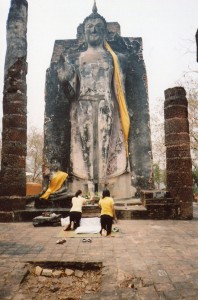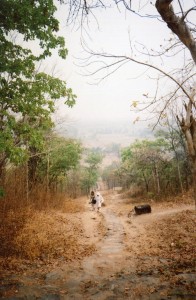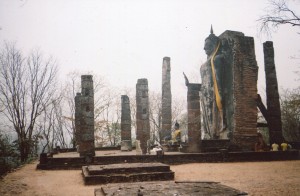I found Sukhothai one of the most enchanting places in the world. The grace in its ritual center (see More Thai Grace in Sukhothai) rippled throughout the surrounding land and into the hills.
Dozens of shrines and monasteries bejewel the land outside the ancient city wall, and many temples glitter in the hillsides. My favorite hill shrine is Wat Saphan Hin. Let’s spread our wings again and explore it.
You reach Saphan Hin by climbing an ancient stairway of large stones. You rise about 200 feet. The steps are unevenly settled, and many are broken now. You thus have to watch your step, but the stones’ weathered states give the approach a romantic air.
At the top is a Buddha statue from the late 13th or early 14th century that’s about 40 feet tall. He has a long oval face and a gentle smile.
The great teacher holds the palm of his long right hand forward in a position that means “Don’t fear” in Indian artistic traditions.
Pillars of the ruined assembly hall surround the statue. This was a great setting for delightful processions, and old Sukhothai conducted many.
An inscription states that Sukhothai’s founder, King Ramkhamhaeng, rode up there on a white elephant’s back during a full moon. When I was there, two women were quietly kneeling in front of the statue. Seven hundred years apart, both ascents up the hill represented continuity of a tradition that mixes beauty and piety. The two women lacked their predecessor’s mount, but not his grace.
Please also see:
Thai Grace in Sukhothai, a Big Difference from Angkor Wat,
Sukhothai Buddha, a Thai Ideal of Beauty and Order,
and to see what was going on in Europe around the same time: Top Gothic Cathedrals, Churches and Chapels.




Comments on this entry are closed.